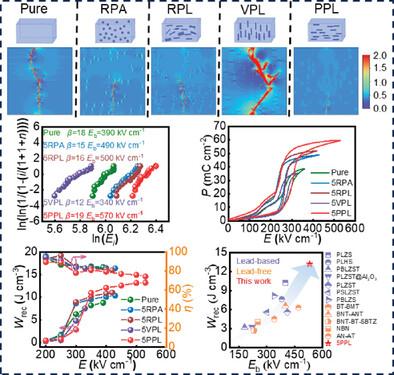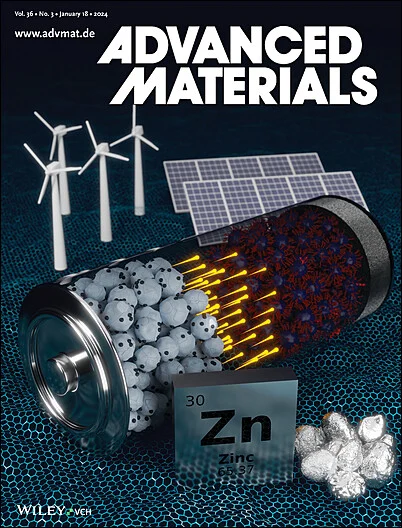Ordering-Structured Antiferroelectric Composite Ceramics for Energy Storage Applications
IF 27.4
1区 材料科学
Q1 CHEMISTRY, MULTIDISCIPLINARY
引用次数: 0
Abstract
Dielectric capacitors possessing high power density and ultrashort discharge time are valuable for high-power energy storage applications. However, achieving high energy storage density remains challenging due to the limited breakdown strength of dielectric ceramics. In this study, inspired by the layered architecture of natural nacre and with the guidance of phase-field simulations, a strategy of constructing a nacre-like layered structure is proposed to improve the breakdown strength and energy storage density of the ceramics. This unique structure is formed by controlling the morphology and ordering of high-voltage-resistant fillers in a ceramic matrix. The (Pb0.98La0.02)(Zr0.7Sn0.3)0.995O3-Al2O3 antiferroelectric composite ceramics, containing 5vol% parallel-aligned Al2O3 plates, demonstrate a remarkable enhancement in breakdown strength from 390 to 570 kV cm−1. Of particular importance is that an ultrahigh recoverable energy storage density of up to 13.2 J cm−3 is achieved, representing a 50% enhancement compared to the pure ceramic (8.7 J cm−3). The parallel-aligned Al2O3 plates are strongly bound together with the ceramic matrix, effectively blocking charge migration and controlling the breakdown path, thus greatly enhancing the voltage endurance of the composite ceramics. This work provides an innovative approach to designing high-performance composite ceramics for next-generation energy storage applications.

求助全文
约1分钟内获得全文
求助全文
来源期刊

Advanced Materials
工程技术-材料科学:综合
CiteScore
43.00
自引率
4.10%
发文量
2182
审稿时长
2 months
期刊介绍:
Advanced Materials, one of the world's most prestigious journals and the foundation of the Advanced portfolio, is the home of choice for best-in-class materials science for more than 30 years. Following this fast-growing and interdisciplinary field, we are considering and publishing the most important discoveries on any and all materials from materials scientists, chemists, physicists, engineers as well as health and life scientists and bringing you the latest results and trends in modern materials-related research every week.
 求助内容:
求助内容: 应助结果提醒方式:
应助结果提醒方式:


